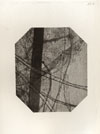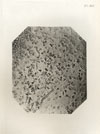





Illustrated with numerous photo-micrographic plates and chromolithographs.
Edinburgh : Oliver and Boyd, 1886.
Description : [1]-263 p., [42] l.s ; ill., 12 chromo.s, 36 photo.s, 1 fig. ; 22.5 cm.
Photographs : 36 photogravures of sputum samples.
Photographer : Francis Troup.
Subject : Respiratory Tract Diseases — Diagnosis.
Cited :
Finlayson, R. "The vicissitudes of sputum cytology" (1958) ; Medical History, Jan., 2(1): 24–35.
Notes :
To secure absolute conformity to truth and reality I have photographed, what in these days of micro-organisms must be called the coarser microscopic constituents of sputum, and have had the negatives employed to illustrate this work reproduced by a process named "Photogravure," which, while equal in clearness and crispness to silver-printing, has the great advantage of being perfectly permanent; its only drawback is it expensiveness, which is so serious as to have caused the omission of many illustrations I had intended to introduce. This task of photogravuring has been successfully accomplished by Messrs Annan & Swan, of London and Glasgow, to whom it was entrusted. My thanks are also due to Mr W. Forgan, President of the Photographic Society, and to Mr Michael Scott, photographic artist : to the former for lessons and excellent advice in photo-micrographic work and construction of the apparatus ; to the latter for instruction in developing. — pages 3-4.
Finlayson remarks that no more than six or seven textbooks on the microscopy of sputa find a place in the medical canon, the first one published in 1855 1 by a protege of Virchow. Troup published Sputum in 1886, the same year that his Edinburgh colleague George Hunter Mackenzie issued his own monograph on the subject, titled A practical treatise on the sputum.2 Motivated by Koch's research into the pathogenesis of the tubercule bacillus published four years earlier, 3 both men were looking for diagnostic value in the elements of the spit cup, especially for any precursors of phthisis which Koch might have pretermitted. Koch had found that simply examining for bacillus in sputum was an unreliable test for the disease :
In order to gain an opinion about the occurrence of tubercle bacilli in phthisis sputum I have examined repeatedly the sputum of a large series of consumptives and have found that in some of them no bacilli are present, and that, however, in approximately one-half of the cases, extraordinarily numerous bacilli are present, some of them sporogenic. Incidentally, it may be remarked that, in a number of specimens of sputum of persons not diseased with phthisis, tubercle bacilli were never found. — Koch
In his chapter on elastic tissue Troup makes the claim that a thorough inspection will reveal "curly fibre" in the sputum of a presymptomatic lung patient, particularly that of the consumptive. Troup writes, "It appears to me that the diagnostic value of curly fibre is apt to be much under-estimated in the present day when the tubercle bacillus, like Aaron's rod, swallows up everything else" and he gives an account of a 60 year-old mason who came to him with an emaciating fever. No mischief could be detected by auscultation, but Troup imports a fatal pulmonary condition in the large quantities of elastic tissue he finds in his patient's sputum and his diagnosis is borne out six weeks later. He repeats his claim for the diagnostic value of curly fiber in a chapter on tuberculosis, writing:
So far as I know, no one has in the very initial stages of acute miliary lung tuberculosis, or of cheesy pneumonia, shown the bacillus in the lung excreta; but from many examinations made long before Koch's discovery was heard of, I know that tissue is to be found from a very early period; and from observations made for comparative purposes since that time my belief remains firm that, presupposing of course necessary patience and skill, curly fibre precedes the advent of the bacillus by a measureable but indefinite time, and will not escape notice if looked for with sufficient perseverance.
Troup provides a chapter on the pigmented expectoration associated with black lung disease, but aside from three florid images of a laryngeal papilloma there are no examples of neoplasts. Lung cancer was rare in the 1800's whereas tuberculosis in its pulmonary manifestation was causus causans of death in the human race (Troup, p. 114). A study of malignant cells in sputa was taken up by Hampeln4 in 1887, however a procedure for diagnostic detection was not perfected until 1935 by Leonard Dudgeon (Finlayson).
Five plates of desquamated elastic tissue provide a comparison between laryngeal and pulmonary phthisis and six more plates provide examples of bacilli, mycelium and sputum artifacts that could be easily mistaken for curly fibre. Plate XXII is the first published example of haemin crystals in a case of a pneumonia. There is a chapter and wonderful set of photographs for Curschmann spirals, and a chapter on alveolar epithelium that is illustrated with a remarkable photomicrograph that is probably the first published image of myelin degeneration in this cell.






1. Biermer, Anton Die Lehre vom Auswurf ; Würzburg: Stahel ; 1855.
2. Mackenzie, George Hunter, A practical treatise on the sputum/ ; Edinburgh: Johnston ; 1886.
3. Koch, Robert, Über die Ätiologie der Tuberkulose ; Berlin: August Hirschwald ; 1882.
4. Hampeln, Paul Über intermittirendes Fieber im Verlauf des Magencarcinoms ; Ztschr. f. klin. Med. ;
Berlin, 1888.
